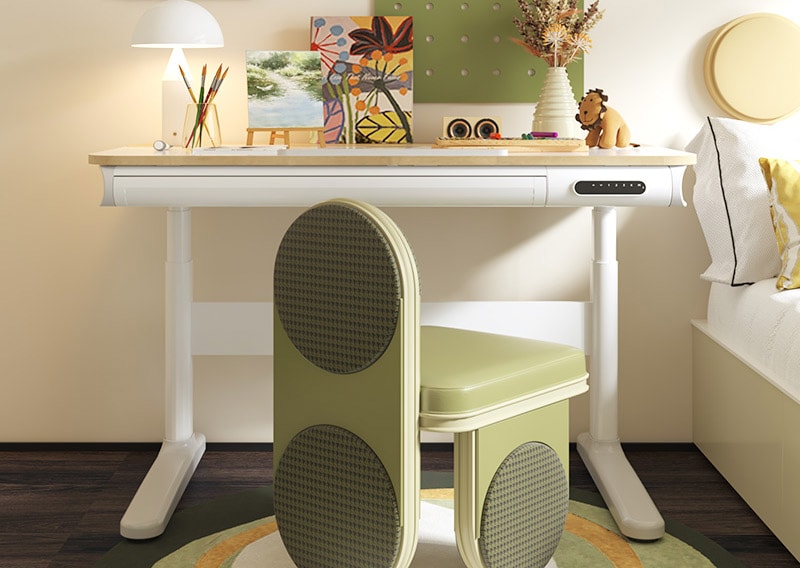Schooling is an essential part of every child's life, as it provides them with the opportunity to learn new skills, acquire knowledge, and develop their personality. However, schooling also involves many challenges and stressors, such as academic demands, social pressures, and environmental factors.
One of these factors is the seating arrangement or kids'desk in the classroom, which can have a significant impact on children's psychological well-being and academic performance. In this blog post, we will explore how different seating arrangements, such as clusters, single desks, or standing desks, affect children's cognitive processes, such as logical reasoning, creativity, and theory of mind.

We will also discuss some individual characteristics that may moderate the effect of seating arrangement on children's outcomes. Finally, we will provide some practical implications and suggestions for parents and teachers who want to support children in a successful transition to secondary education.
What Is The Difference Between Clusters, Single Desks, And Standing Desks?
Clusters are a seating arrangement in which students sit in groups of four or six around a shared table or desk. This arrangement is often used to facilitate collaborative learning, peer interaction, and social skills development.
Single desks are a seating arrangement in which students sit individually at separate desks or tables. This arrangement is often used to promote individual work, concentration, and self-regulation.
Standing desks or height adjustable desks are a seating arrangement in which students can choose to stand or sit at adjustable-height desks or tables. This arrangement is often used to encourage physical activity, posture improvement, and health benefits.
How Does Seating Arrangement Affect Children's Cognitive Processes?
According to a recent experimental study by Tobia et al. (2022), changing the seating arrangement from clusters to single desks can have a positive effect on children's logical reasoning skills. Logical reasoning is the ability to apply rules and principles to solve problems and draw valid conclusions.
The researchers found that when children were seated in single desks, their score in logical reasoning was globally higher than when they were seated in clusters. This suggests that single desks may provide a more conducive environment for logical thinking, as they reduce distractions and increase focus.
However, the effect of seating arrangement on children's creativity and theory of mind was more complex and depended on some individual characteristics. Creativity is the ability to generate novel and useful ideas or products. Theory of mind is the ability to understand and predict the mental states of others, such as their beliefs, desires, and emotions.
The researchers found that when children were seated in single desks, girls showed a better performance in theory of mind than when they were seated in clusters. This may indicate that girls are more sensitive to social cues and can benefit from having more personal space and privacy.
On the other hand, when children were seated in single desks, lonelier children performed better in theory of mind and creativity than when they were seated in clusters. This may suggest that lonelier children are more motivated to engage in imaginative activities and mental simulations when they are isolated from their peers.
Another recent study by Evans et al. (2018) examined the effect of standing desks on children's cognitive processes and academic achievement. The researchers found that using standing desks for 16 weeks improved children's executive functions, such as working memory, inhibition, and cognitive flexibility. Executive functions are higher-order cognitive processes that enable goal-directed behavior and problem-solving.
The researchers also found that using standing desks increased children's reading comprehension scores by 12%. This implies that standing desks may enhance children's cognitive abilities by increasing blood flow to the brain, reducing sedentary behavior, and stimulating physical activity.
What Are The Implications And Suggestions For Parents And Teachers?
The findings of these studies imply that there is no one-size-fits-all solution for choosing the best seating arrangement for learning in classrooms. Different seating arrangements may have different effects on different cognitive processes and different types of students. Therefore, parents and teachers should consider both the nature of the task and the individual characteristics of the child when deciding on a seating arrangement for learning.
For example, if the task requires logical reasoning or concentration, single desks may be more suitable than clusters or standing desks. However, if the task requires creativity or social skills development, clusters or standing desks may be more suitable than single desks.
Moreover, parents and teachers should be aware that the transition from primary to secondary education is a stressful event for many children, as it involves changing schools, teachers, classmates, curricula, and expectations. This transition can have a negative impact on children's psychological well-being and academic achievement. Therefore, parents and teachers should provide children with adequate support and guidance during this period.
For instance, they can help children cope with their emotions, foster their self-esteem and confidence, encourage their participation and involvement, and create a positive and welcoming atmosphere.
Final Word
In conclusion, children's desks or seating arrangement is an important factor that can influence children's psychological well-being and academic performance in school. However, it is not the only factor that matters. Parents and teachers should also take into account other factors, such as the task requirements and the child's individual characteristics, when choosing a seating arrangement for learning.
Furthermore, parents and teachers should support children during the transition from primary to secondary education by helping them manage their emotions effectively, boosting their self-esteem, promoting their engagement, and creating a positive environment. By doing so, they can help children achieve their full potential and enjoy their schooling experience.